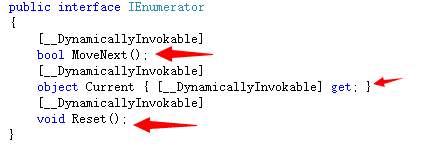简介:
前两篇文章讲了关于泛型的一些基础,下面笔者通过这篇文章来给刚刚接触泛型的朋友介绍一下
<1>.原理性的东西----” 泛型的协变和逆变 “
<2>.以及常用的接口----” IEnumerable 及其泛型版的IEnumerable<out T> “
------------------------------------------------------------------------------------------------------------------------------------------------------------
<泛型的协变与逆变|泛型修饰符‘out’与‘in’>
|首先这2个拗口的名词先不用去管它,先知道协变和逆变主要是用在泛型的接口和委托上就可以了,下面我们通过一个例子来看看:
|在这之前我们插点别的东西,我们知道接口是可以体现多态的,当然接口体现的多态注重的功能上的多态,这和抽象类不同,抽象类更注重的是建立在血缘关系上的多态。
知道接口是可以体现多态的之后,我们来看看一个相关的例子--
鸟和飞机都会飞,把飞定义成一个借口,在定义2个类
public interface IFlyable
{
void fly();
}
class Bird:IFlyable
{
public void fly()
{
Console.WriteLine("鸟儿飞!");
}
}
class Plane:IFlyable
{
public void fly()
{
Console.WriteLine("飞机飞!");
}
}
下面看看接口体现的多态性:
IFlyable ifly;
ifly = new Bird();
ifly.fly();
ifly = new Plane();
ifly.fly();
运行结果:
鸟儿飞!
飞机飞!
了解了接口的多态性后我们再来看一个例子:
这里定义了2个类 Animal 和 Cat (Cat继承了Animal)
public class Animal
{
}
public class Cat:Animal
{
}
继续往下看:
Cat cat = new Cat();
下面这句代码,cat向animal转,子类向父类转换,这时cat会隐式转换为animal 我们说“儿子像父亲” 这是完全可以理解的
Animal animal = cat;
但是 说”父亲像儿子“ 这是说不过去的 ,但是有的时候如果儿子坑爹,强制转换了一下还是可以的
cat = (Cat)animal;
(协变)
List<Cat> catArray = new List<Cat>();
List<Animal> animalArray = catArray;
如果是上面说的类,这样写是可以的,但是这里是会报错的 如图

继续往下看 这样写却可以
IEnumerable<Cat> lCat = new List<Cat>();
IEnumerable<Animal> lAnimal = lCat;
对 IEnumerable<Cat> 转到定义 如图 我们发现这里多了一个 “out” 关键字

概念引入:
1.对于泛型类型参数,out 关键字指定该类型参数是协变的。 可以在泛型接口和委托中使用 out 关键字。“协变”是指能够使用与原始指定的派生类型相比,派生程度更大的类型。
--对于 “协变” 笔者是这样理解的就是”说的通变化“ 就像 “儿子像父亲一样”(假定父亲派生程度0那么儿子的派生程度就是1了,所以父亲可以使用派生程度更大的儿子)
协变与多态性类似,因此它看起来非常自然。
(逆变)
我们知道IComparable<T>接口中,T的修饰符是‘in’,下面我们修改一下上面的代码演示一下
class Cat : Animal, IComparable<Cat>
{
//仅演示
public int CompareTo(Cat other)
{
return 1;
}
}
class Animal : IComparable<Animal>
{
//仅演示
public int CompareTo(Animal other)
{
return 1;
}
}
这里Cat和Animal都实现了IComparable<T>接口,然后我们这样写
IComparable<Cat> ICat = new Cat();
IComparable<Animal> IAnimal = new Animal();
ICat = IAnimal;
代码中ICat(高派生程度)使用 IAnimal(低派生程度) “父亲像儿子” 和上面的例子完全相反。
概念引入:
2.对于泛型类型参数,in 关键字指定该类型参数是逆变的。 可以在泛型接口和委托中使用 in 关键字。“逆变”则是指能够使用派生程度更小的类型。
--对于 “逆变” 笔者的理解则是 “坑爹儿子” 反过来硬说 “父亲像儿子” 这是 “说不过去的” 只是利用了强硬的手段
在了解了上面的内容后,我们来看看“out” 与 “in” 关键字的特性
IEnumerable<T>接口的IEnumerator<T> GetEnumerator()方法返回了一个迭代器 ,不难发现T如果用 out 标记,则T代表了输出,也就说只能作为结果返回。
IComparable<T>接口的CompareTo(T other)方法传入了一个T类型的Other参数,不难发现T如果用 in 标记,则T代表了输入,也就是它只能作为参数传入。
下面我们演示一个例子
将动物会叫这功能,定义成一个泛型借口用 out 修饰

这里会出现一个错误

把第二个带参数的setSound方法,去掉后编译可以正常通过
下面我们把 out 改成 in

这里会出现一个错误

把第一个setSound方法,去掉后编译可以正常通过,或者把第一个方法的返回值,改成其它非T类型,编译也可通过
这个演示充分说明了:out 修饰 T 则 T只能作为结果输出而不能作为参数 ; in 修饰 T 则 T只能作为参数而不能作为结果返回;
------------------------------------------------------------------------------------------------------------------------------------------------------------
<IEnumerable接口及其泛型版>
为什么要用IEnumerable接口? 下面我们通过一个例子看看:
//定义Person类
public class Person
{
public Person(string _name)
{
this.name = _name;
}
public string name;
}
//定义People类
public class People
{
private Person[] _people;
public People(Person[] pArray)
{
//实例化数组 用于存Person实例
_people = new Person[pArray.Length];
for (int i = 0; i < pArray.Length; i++)
{
_people[i] = pArray[i];
}
}
}
上面的代码我们定义了一个 Person 类和一个 People 类,显然 People是用来存放多个Person实例的集合,下面我们尝试用 Foreeach 遍历集合的每个元素 输出:
static void Main(string[] args)
{
Person[] personArray = new Person[3]{
new Person("Keiling1"),
new Person("Keiling2"),
new Person("Keiling3"),
};
People people = new People(personArray);
foreach (Person item in people)
{
Console.WriteLine(item.name);
}
}
这里编译不能通过,出现了一个错误

GetEnumerator:是IEnumerable接口中的一个方法,它返回一个 IEnumerator(迭代器),如下图

IEnumerator内部规定了,实现一个迭代器的所有基本方法,包括 如下图

为了在foreach中使用 People的实例, 我们给People实现IEnumerable接口,代码如下:
public class People:IEnumerable
{
private Person[] _people;
public People(Person[] pArray)
{
//实例化数组 用于存Person实例
_people = new Person[pArray.Length];
for (int i = 0; i < pArray.Length; i++)
{
_people[i] = pArray[i];
}
}
////IEnumerable和IEnumerator通过IEnumerable的GetEnumerator()方法建立了连接,可以通过IEnumerable的GetEnumerator()得到IEnumerator对象。
IEnumerator IEnumerable.GetEnumerator()
{
return (IEnumerator)GetEnumerator();
}
public PeopleEnum GetEnumerator()
{
return new PeopleEnum(_people);
}
}
public class PeopleEnum:IEnumerator
{
public Person[] _people;
public PeopleEnum(Person [] pArray)
{
_people = pArray;
}
//游标
int position = -1;
//是否可以往下 移
public bool MoveNext()
{
position++;
return (position < _people.Length);
}
//集合的所有元素取完了之后 重置position
public void Reset()
{
position = -1;
}
//实现 IEnumerator的 Current方法 返回当前所指的Person对象
object IEnumerator.Current
{
get
{
return Current;
}
}
//Current是返回Person类实例的只读方法
public Person Current
{
get
{
try
{
return _people[position];
}
catch (IndexOutOfRangeException)
{
throw new InvalidOperationException();
}
}
}
}
测试运行:
static void Main(string[] args)
{
Person[] personArray = new Person[3]{
new Person("Keiling1"),
new Person("Keiling2"),
new Person("Keiling3"),
};
People people = new People(personArray);
foreach (Person item in people)
{
Console.WriteLine(item.name);
}
}
结果:

总结:
1.一个集合要支持foreach方式的遍历,必须实现IEnumerable接口,描述这类实现了该接口的对象,我们叫它 ‘序列’。
比如 List<T> 支持 foreach 遍历 是因为它实现了IEnumerable接口和其泛型版,如图--

2. IEnumerator对象具体实现了迭代器(通过MoveNext(),Reset(),Current)。
3. 从这两个接口的用词选择上,也可以看出其不同:IEnumerable是一个声明式的接口,声明实现该接口的class是“可枚举(enumerable)”的,但并没有说明如何实现迭代器,
而IEnumerator是一个实现式的接口,IEnumerator对象就是一个迭代器。
关于IEnumerable<T>我们来了解一下它的代码:

出自: Keiling_J'Blog http://www.cnblogs.com/keiling/